Dateline – December 23, 2019 – Lewisville, Texas
It’s always nice to find a group of Hooded Mergansers in a new location in the metroplex. I recently stumbled across these in a pond located in a small residential park.
Hooded Mergansers are winter migrants in the metroplex. They come here in relatively small numbers compared to some of our other winter ducks–such as Gadwalls and Northern Shovelers. They also tend to prefer certain specific waterways year after year, though the appeal of these particular habitats is not readily apparent–at least not to me. Because of these factors, discovering a new congregation of these beautiful ducks is always exciting.
For most of my visit on this cold winter morning there were only a half dozen or so mergansers present. But the starkly colored ducks were busy coming and going the entire time, so that at one point we had a full dozen in the contingency–roughly evenly divided between males and females.


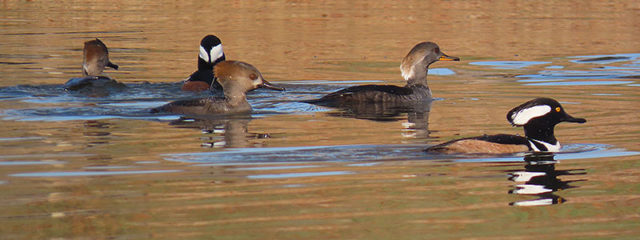






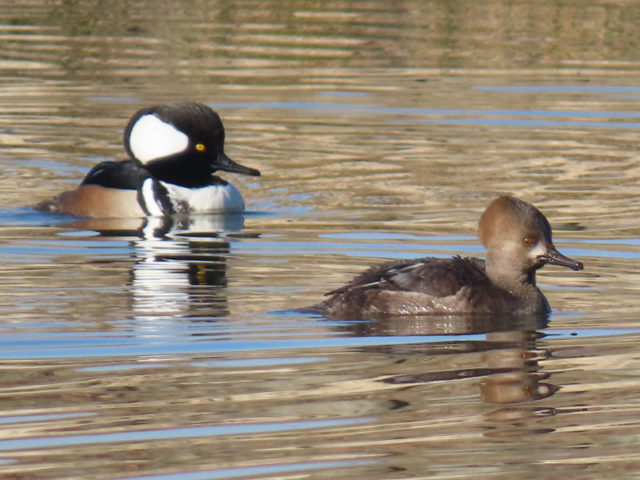
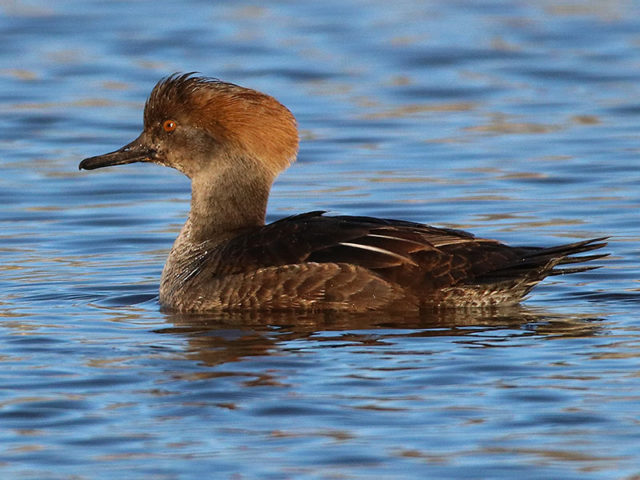



Hooded Mergansers are interesting ducks. Their appearance is unique, and so too are many of their behaviors. Roughly crow-sized, these small diving ducks feed primarily on small fish and aquatic invertebrates. Here is how Wikipedia describes the Hooded Merganser…
The hooded merganser is a sexually dimorphic species. The adult female has a greyish-brown body, with a narrow white patch over the lower breast and belly. She has a light reddish-brown crest extending from the back of the head. During the nonbreeding season the male looks similar to the female, except that his eyes are yellow and the female’s eyes are brown.
In breeding plumage the dorsal areas and the head, neck and breast of the mature male are mainly black with white markings; there are large white patches on either side of the crest, and they are particularly conspicuous when he raises his crest during courtship. His lower flanks are a rich reddish-brown or chestnut in colour, and the breast and undersides are more or less white, extending into white stripes across the crop and breast.
In both sexes there are narrow white stripes along the tertial wing feathers; when the bird is in repose they have the appearance of longitudinal white stripes along the bird’s lower back, if they are visible.
First-winter birds differ from adult females in appearance in that they have a grey-brown neck and upper parts; the upper parts of adult females are much darker — nearly black. Furthermore, the young birds have narrower white edges to their tertial feathers than adults do. Females of all ages are dark-eyed, whereas in males the eyes become pale during their first winter


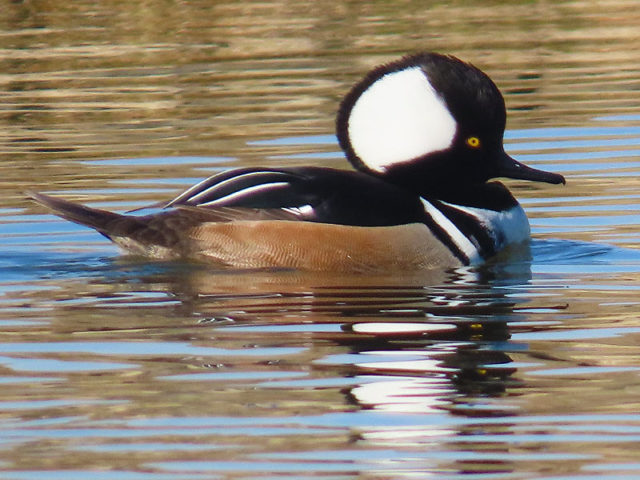

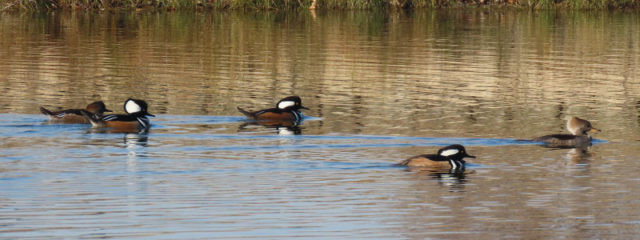
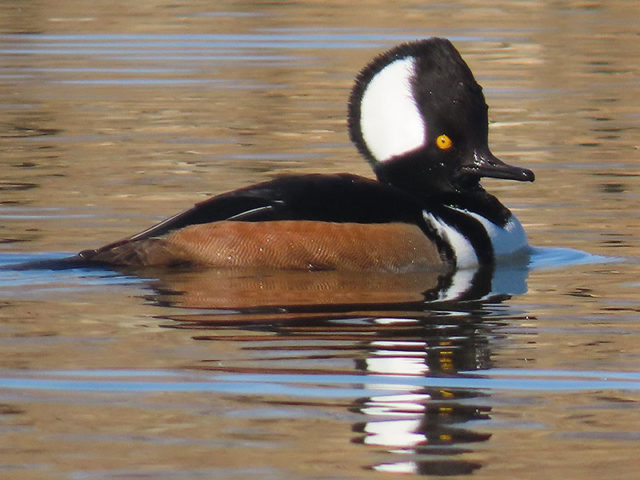


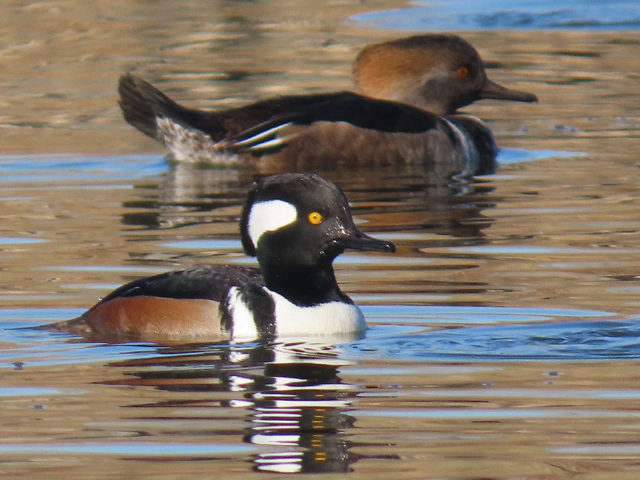



odd merganser (back-right) and a more typical female (front-right)
The following sequence of four pictures begins with two mergansers–a male and a female. They are soon joined by another pair coming up from the depths. Finally, a non-breeding male pops up, and the entire groups moves on together…



side of the male and female in the background




Juvenile male, uncertain, breeding male, and adult female
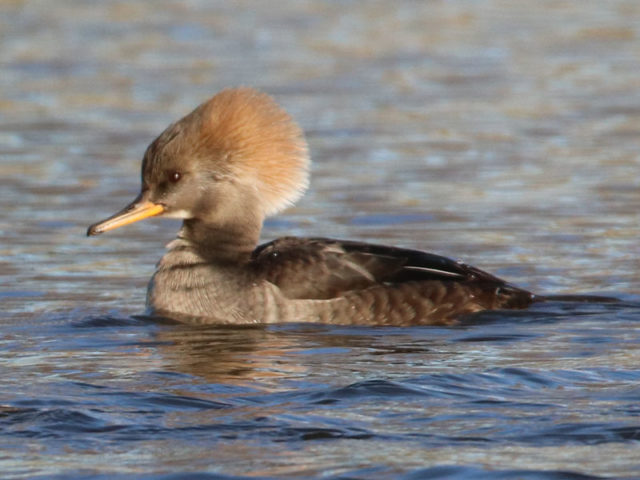

Meanwhile on the opposite side of the pond this pretty little pair motored in circles. These are Ring-necked Ducks, another relatively rare winter visitor to the Dallas/Fort Worth metroplex. Only a handful of these ducks are usually present at any given location.



Ring-necked Ducks superficially resemble the much more common Lesser Scaup. Scaups can gather into large numbers in certain places around the metroplex. If you look carefully at such a congregation you might notice an odd duck or two with a white and black tipped bill–those are Ring-necked Ducks!

white and black bands on the tip of the bill
Here is what Wikipedia has to say about the Ring-necked Duck…
Ring-necked ducks are small to medium-sized diving ducks. The adult male is similar in color pattern to the Eurasian tufted duck, its relative. Males are a little bit bigger than the female. It has two white rings surrounding its gray bill, a shiny black angular head, black back, white line on the wings, a white breast and yellow eyes. The adult female has a grayish brown angular head and body with a dark brown back, a dark bill with a more subtle light band than the male, grayish-blue feet and brown eyes with white rings surrounding them. Females also make a noise like trrr. The cinnamon neck ring is usually difficult to observe, which is why the bird is sometimes referred to as a “ringbill”.



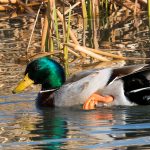



Hello Chris, your merganser and other duck photos are interesting, and it is a tribute to your patience as a photographer that you are able to get such good photos.
Though I won’t claim expertise, I do believe that your “uncertain” sex merganser is simply an immature female. Check detailed field guides like Sibley’s or the Cornell Laboratory.
With regards to relative numbers of ring neck and lesser scaup, back in the late sixties/early seventies ring neck ducks were exceedingly common in North Texas, especially on Cedar Lake west of Gainsville, and on North Lake, a Dallas Power and Light Company reservoir that I believe is now filled in, but that formerly was on the property NE of Belt Line Road and Valley View. But in later years I noticed a decline in their numbers. Though I see them sometimes on small bodies of water, they (like scaup) are more abundant on larger waters. Perhaps the warmer winters of recent years have resulted in them staying further north, since there is more open water there than there used to be.
Oh, meant to mention: I was in the metroplex for a week over New Years Day. I saw both lesser scaup (many) and ring neck ducks on both the private lake behind the Double Tree Hotel in Farmer’s Branch, and the Elm Fork of the Trinity River at the Clear Creek Nature Preserve in Denton/Collin Counties. Blue winged and green winged teal were also at the latter location. There were both these species, as well as mallards (possibly feral domestic pekin ducks in mallard plumage — some were very large) and American widgeon on the creek at the Farmer’s Branch park by the FB City Hall.
I have stumped many of my expert resources with that merganser, David. If you look at the last merganser picture in the series (the odd duck and an adult female) I think you can see hints of a male’s white and black breast markings. Another good look is in the second picture up from that one where you can compare the odd duck to and adult male and two adult females. Or, it might just be a trick of the light. I am perplexed!
-Chris